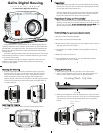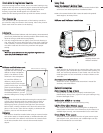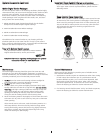
13 14
G
G
e
e
n
n
e
e
r
r
a
a
l
l
T
T
i
i
p
p
s
s
1. Due to the power required to operate the camera, flash, and
LCD screen, it is a good idea to start each dive with a fresh set
of batteries.
2. Some cameras reset their flash to AUTO when the camera is
turned on. If you prefer another setting be sure to select it.
3. As soon as you enter the water, take a moment and check the
housing to see that it is properly sealed.
4. Next, check to see if there are any bubbles on the face of the
lens port. If there are, take your finger and remove them. If
there are bubbles on the lens port they can produce soft focus
spots in your photographs.
5. If you are shooting with the camera’s built-in flash and the
cameras lens is set to the widest angle, you may need to zoom
t
he lens slightly or a shadow may appear in the lower left
corner of close-up photographs. The lens port may block some
of the light. Installing the flash diffuser will help to eliminate
the shadow.
(You can test this above water)
To shoot photographs closer than 2 feet (0.6m), you need to
use an external strobe such as the AF35, DS51, DS125, or DS160.
With an external strobe you can position it so nothing blocks
the light path between the strobe and the subject.
6
NNOOTTEE::
Fogging of the port glass may occur due to a variety of
environmental factors. To prevent fogging issues, always
assemble the housing in a cool, dry area, and keep the housing
out of direct sunlight. If fogging persists, insert a fresh dessicant
packet inside the housing before each day of diving (dessicant
packages are not available from Ikelite, however most camera
stores carry them).
7. Before placing your camera in the housing, it is a good idea to
immerse the closed housing in a bucket or rinse tank to make
sure it is watertight.
15
P
P
h
h
o
o
t
t
o
o
T
T
i
i
p
p
s
s
1. The number one rule in underwater photography is to eliminate
as much water between the camera and subject as possible. Get
as close as you can to the subject, then use the zoom if
necessary. If you are using flash, subjects beyond 6 feet (1.8m)
will not have much color regardless of strobe power.
2. The camera’s built-in flash is very close to the camera lens. The
flash can light up any suspended particles in the water and they
can be recorded in your picture. This effect is called backscatter.
T
o eliminate as much backscatter as possible, photograph close,
photograph in clear water, and do not stir up the sand or silty
bottom. If backscatter becomes a problem in the environment
you are photographing, an external flash will help eliminate
m
uch of the backscatter.
3. Digital cameras have a slight lag time between when you press
the shutter release button and the camera actually takes the
picture. Hold the camera steady a second or two after pressing
t
he shutter release button.
4. Do not shoot down on subjects as they will quite often blend
into the background and be difficult to see in the photograph.
Shoot subjects straight on or shoot up at a slight angle using
the blue water as a contrasting background.
5. Underwater flash is used to restore the warmer colors filtered
out by the water as well as to illuminate the subject. When
photographing underwater, set the camera to use flash on
every shot. If the camera’s flash is set to AUTO and the sun is
behind your subject, the camera may see enough light that it
does not fire the flash. With the sun behind the subject, the
subject is shaded (dark) and needs flash for a good exposure.
6. If over-exposure occurs, enable macro setting. If over-exposure
continues, zoom in and back away from the subject.
IIkkeelliittee LLiimmiitteedd WWaarrrraannttyy
All Ikelite products are warranted against any manufacturing
defects for a period of one year from the date of purchase.
Defective products should be returned prepaid to Ikelite. Ikelite
will, at its discretion, repair or replace such products, and will
return to customer prepaid. All other claims, of any nature,
including but not limited to bulb failure are not covered. Except
as mentioned above, no other warranty expressed or implied,
applies to this Ikelite product.
RReettuurrnniinngg PPrroodduuccttss ffoorr SSeerrvviiccee
Ikelite is most interested in preforming any service to assure that
all products perform as intended. For repair or service, return the
product to the address below with your name, address, phone
number and a brief description of the problem. Evidence of
purchase date must be provided to obtain warranty service.
Normal service turnaround time is approximately 2-3 weeks.
IIkkeelliittee UUnnddeerrwwaatteerr SSyysstteemmss
5500 WW 3333rrdd SSttrreeeett
IInnddiiaannaappoolliiss,, IINN 4466220088 UUSSAA
WWhheenn rreettuurrnniinngg pprroodduuccttss sseenndd ““aattttnn.. RReeppaaiirr DDeepptt..””
331177--992233--44552233
““ggeenneerraall qquueessttiioonnss”” ee--mmaaiill:: iikkeelliittee@@iikkeelliittee..ccoomm
wwwwww..iikkeelliittee..ccoomm
UULLTTRRAAccoommppaacctt DDiiggiittaall--0011--00770088
PPhhoottoo TTiippss CCoonntt..
7. If your camera consistently over or underexposes the image
when using daylight or flash, you may want to adjust your
camera’s exposure compensation settings (if offered on your
model). Many cameras allow you to adjust both available light
and flash exposure with an EV “Exposure Compensation”
control in the camera’s menu.
8. Many photographers transfer their images to the computer
where they can fine tune the appearance of the image. Many
of the image manipulation programs make you think you can
magically correct any image taken and make a good picture.
Note that if the image is overexposed, much of the color is
missing. If the color is missing you cannot adjust it. If images
are slightly underexposed, the color is there, and you can adjust
exposure to some degree. So, if you error in exposure, it is
better to have the image slightly underexposed rather than over
exposed.






